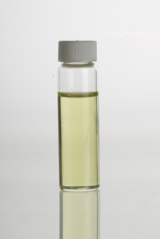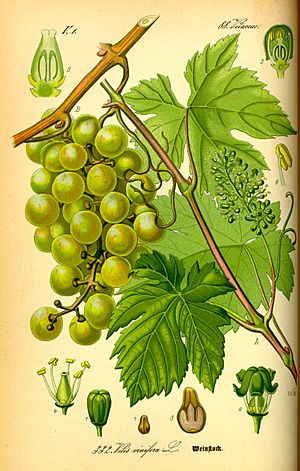Grape seed oil facts for kids

Grape seed oil in clear glass vial
|
|
| Fat composition | |
|---|---|
| Saturated fats | |
| Total saturated | Palmitic: 7% Stearic: 4% |
| Unsaturated fats | |
| Total unsaturated | 86% |
| Monounsaturated | 16.1% |
| Palmitoleic acid | <1% |
| Oleic acid | 15.8% |
| Polyunsaturated | 69.9% |
| Omega-3 fatty acids | α-Linolenic: 0.1% |
| Omega-6 fatty acids | Linoleic: 69.6% |
| Properties | |
| Food energy per 100 g (3.5 oz) | 3,700 kJ (880 kcal) |
| Smoke point | 216 °C (421 °F) |
| Iodine value | 124-143 |
| Saponification value | 126 (NaOH) 180-196 (KOH) |
| Unsaponifiable | 0.3% - 1.6% |
| Peroxide value | 2.92 mequiv/kg |
Grape seed oil is a special oil made from the tiny seeds of grapes. It's a vegetable oil that comes from the same grapes used to make wine. This means it's a useful product created from something that might otherwise be thrown away. People mostly use it for cooking and in food.
Contents
How Grape Seed Oil is Used
Cooking with Grape Seed Oil
Grape seed oil is great for cooking because it can get very hot before it starts to smoke. This is called its smoke point, and for grape seed oil, it's about 216 °C (421 °F).
It has a clean and light taste, which means it won't change the flavor of your food too much. It's also high in healthy fats called polyunsaturated fats.
Because of these qualities, it's often used in salad dressings and mayonnaise. You can also use it to make oils flavored with garlic, rosemary, or other herbs and spices. It's popular in baked goods like pancakes and waffles. Sometimes, it's even sprayed on raisins to help them stay fresh and flavorful.
Research and Studies
Scientists study grape seed oil to learn more about its parts. They look at different types of grapes to see how the oil's makeup changes. For example, they check the amounts of different fats and vitamins in the oil.
Grape seeds have special plant compounds called polyphenols. However, the oil itself usually has very small amounts of these. Researchers are still looking into how the parts of grape seed oil might be good for human health. More studies are needed to fully understand any health benefits.
Keeping Grape Seed Oil Safe
Sometimes, grape seed oil can have unwanted substances in it. This can happen if the grape seeds come into direct contact with hot gases during the drying process. Makers of grape seed oil work to prevent this to keep the oil safe for everyone to use.
How Grape Seed Oil is Made
Most grapes grown around the world are used to make wine. When wine is made, the seeds of the grapes are left over. These seeds are a useful by-product that can be pressed to get the oil out.
Because of this, most grape seed oil is made in places where a lot of wine is produced. This includes areas around the Mediterranean Sea, which are famous for their vineyards.
What's Inside Grape Seed Oil
Grape seed oil is made up of different types of fats called fatty acids. These fatty acids are the building blocks of fats. Here's a look at the main ones found in grape seed oil:
| Acid | Type | Percentage |
|---|---|---|
| Linoleic acid | Omega-6 unsaturated | 69.6% |
| Oleic acid | Omega-9 unsaturated | 15.8% |
| Palmitic acid | Saturated | 7% |
| Stearic acid | Saturated | 4% |
| Alpha-linolenic acid | Omega-3 unsaturated | 0.1% |
| Palmitoleic acid | Omega-7 unsaturated | less than 1% |
Grape seed oil also contains small amounts of other helpful things. These include phenols (like tocopherols) and steroids. It has a little bit of vitamin E, but other oils like safflower oil or rice bran oil have more. Grape seed oil is known for being high in polyunsaturates (healthy fats) and low in saturated fats.
Comparing with Other Vegetable Oils
Properties of vegetable oils
| The nutritional values are expressed as percent (%) by mass of total fat. | |||||||||
| Type | Processing treatment |
Saturated fatty acids |
Monounsaturated fatty acids |
Polyunsaturated fatty acids |
Smoke point | ||||
|---|---|---|---|---|---|---|---|---|---|
| Total | Oleic acid (ω-9) |
Total | α-Linolenic acid (ω-3) |
Linoleic acid (ω-6) |
ω-6:3 ratio |
||||
| Avocado | 11.6 | 70.6 | 52–66 | 13.5 | 1 | 12.5 | 12.5:1 | 250 °C (482 °F) | |
| Brazil nut | 24.8 | 32.7 | 31.3 | 42.0 | 0.1 | 41.9 | 419:1 | 208 °C (406 °F) | |
| Canola | 7.4 | 63.3 | 61.8 | 28.1 | 9.1 | 18.6 | 2:1 | 238 °C (460 °F) | |
| Coconut | 82.5 | 6.3 | 6 | 1.7 | 175 °C (347 °F) | ||||
| Corn | 12.9 | 27.6 | 27.3 | 54.7 | 1 | 58 | 58:1 | 232 °C (450 °F) | |
| Cottonseed | 25.9 | 17.8 | 19 | 51.9 | 1 | 54 | 54:1 | 216 °C (420 °F) | |
| Flaxseed/linseed | 9.0 | 18.4 | 18 | 67.8 | 53 | 13 | 0.2:1 | 107 °C (225 °F) | |
| Grape seed | 10.5 | 14.3 | 14.3 | 74.7 | – | 74.7 | very high | 216 °C (421 °F) | |
| Hemp seed | 7.0 | 9.0 | 9.0 | 82.0 | 22.0 | 54.0 | 2.5:1 | 166 °C (330 °F) | |
| Olive | 13.8 | 73.0 | 71.3 | 10.5 | 0.7 | 9.8 | 14:1 | 193 °C (380 °F) | |
| Palm | 49.3 | 37.0 | 40 | 9.3 | 0.2 | 9.1 | 45.5:1 | 235 °C (455 °F) | |
| Peanut | 16.2 | 57.1 | 55.4 | 19.9 | 0.318 | 19.6 | 61.6:1 | 232 °C (450 °F) | |
| Rice bran oil | 25 | 38.4 | 38.4 | 36.6 | 2.2 | 34.4 | 15.6 | 232 °C (450 °F) | |
| High-oleic safflower oil | 7.5 | 75.2 | 75.2 | 12.8 | 0 | 12.8 | very high | 212 °C (414 °F) | |
| Sesame | 14.2 | 39.7 | 39.3 | 41.7 | 0.3 | 41.3 | 138:1 | ||
| Soybean | partially hydrogenated | 14.9 | 43.0 | 42.5 | 37.6 | 2.6 | 34.9 | 13.4:1 | |
| Soybean | 15.6 | 22.8 | 22.6 | 57.7 | 7 | 51 | 7.3:1 | 238 °C (460 °F) | |
| Walnut oil | unrefined | 9.1 | 22.8 | 22.2 | 63.3 | 10.4 | 52.9 | 5:1 | 160 °C (320 °F) |
| Sunflower | 8.99 | 63.4 | 62.9 | 20.7 | 0.16 | 20.5 | 128:1 | 227 °C (440 °F) | |
| Cottonseed | hydrogenated | 93.6 | 1.5 | 0.6 | 0.2 | 0.3 | 1.5:1 | ||
| Palm | hydrogenated | 88.2 | 5.7 | 0 | |||||
See also
 In Spanish: Aceite de pepitas de uva para niños
In Spanish: Aceite de pepitas de uva para niños


